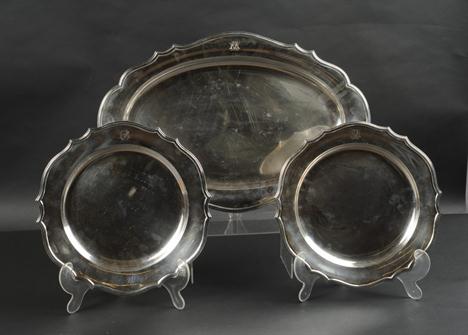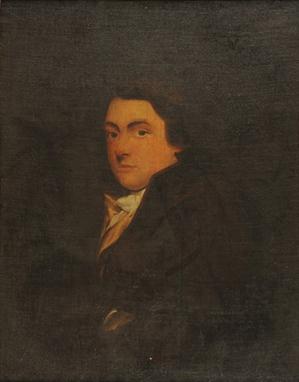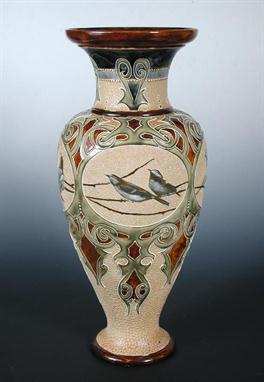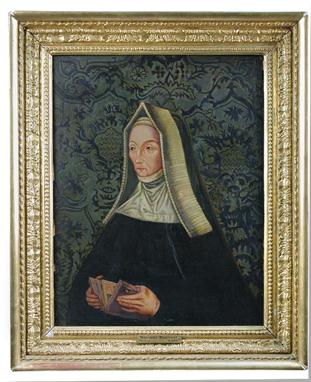We found 297887 price guide item(s) matching your search
There are 297887 lots that match your search criteria. Subscribe now to get instant access to the full price guide service.
Click here to subscribe- List
- Grid
-
297887 item(s)/page
A GEORGE IV TRIPLE CASED POCKET WATCH by George Prior, London, manufactured for the Turkish Market, the circular white enamel dial with black Turkish numerals and later brass hands, the fusee verge movement signed Geo Charle, No. 8010 with a plain circular silver case, hallmarked London 1786. Approximate diameter 50mm. The silver dust case with engraved and chased decoration to the circular bezel and top rim, hallmark London 1786-87, maker`s mark I. R. Approximate diameter 60mm. The tortoiseshell outer case with silver mounts and beaded rivet decoration, approximately 70mm. All within a later Middle Eastern silver case with foliate engraved decoration and scalloped edge. Approximate diameter 82mm. See illustration
DER MODERNE BUCHSCHMUCK IN RUSSLAND (CONTEMPORARY BOOK ILLUSTRATION IN RUSSIA) Edited by Sergei Makovsky, text by N. Radlov, St Petersburg, R. Golicke and A. Willborg, 1914, text in German, with 137 illustrations, some in colour, and 19 plates, mostly in colour, illustrations by Alexander Benois, Konstantin Somov, Leon Bakst, Evgeny Lanceray and others.
A silver Ink Stand, by David Muncey, London 1912, of plain octagonal shape with moulded edge raised on four claw and ball feet, having a rectangular sealing wax box with hinged cover flanked by two square glass inkwells, the box cover inscribed `Presented by The C(ambridge) & I(sle) of E(ly) Agri: Soc: to Mr R Peters FCIS at the Jubilee Show Cambridge July 24th 1913.......`, 28.25cm, 33oz.
English School, Portrait of Margaret Beaufort, Countess of Richmond (1441-1509) oil on panel, 56 x 44cm (21.84 x 17.16in). Provenance: The Hon Hugh Lawson Johnson, Melchbourne Park, Bedfordshire, thence by descent. Margaret Beaufort was mother of Henry VII, the Founder of St John`s College and Christ`s College, Cambridge. She was born at Bletsoe Castle, Bedfordshire. Sir John St John was her half-brother. The original panel was, in 1904, in the possession of the 16th Baron St John at Melchbourne - copied from the original painting by Wilfred B Egan in December, 1904. Lady Margaret`s royal status was derived illegitimately from her paternal great grandfather, John of Gaunt, Duke of Lancaster – the fourth son of Edward III. Her father, John Beaufort, Duke of Somerset, was a disgraced military commander who died shortly before she was one year old. Subsequently, Lady Margaret was placed as a ward under the Marquess of Suffolk, who betrothed young Margaret to her son at the age of six. In 1453, the Lancastrian Henry VI dissolved the marriage and decided that she should instead marry Edmund Tudor, the son of Catherine of Valois, the Queen of Henry V, reinforcing the Lady`s royal status. Margaret Beaufort was the progenitor of the Tudor line. By the time Lady Margaret gave birth to Henry Tudor (at the age of 13) she was already a widow. After the murder of Henry VI in 1471 and the accession of the Yorkist Edward VI, she fled to France with her son, the next male in the Lancastrian family line. For further safety, Lady Margaret married Thomas, 2nd Baron Stanley, in 1472, a powerful figure and a Yorkist supporter at that time. Margaret accepted the Yorkist supremacy for the remainder of Edward`s reign, however after the accession of Richard III and the murder of the Princes in the Tower, she began to plot their overthrow and push for her son`s succession. Her involvement and the failure of the Duke of Buckingham`s rebellion in 1484 saw her estate handed over to the control of her husband, who also agreed to be her gaoler. Despite this, Lady Margaret continued to push for Richard`s overthrow and was instrumental in negotiating the marriage between her son and Elizabeth of York, an important match as it signified the union of the two houses of York and Lancaster, further increasing Henry`s claim to the throne. Lady Margaret`s role changed after Henry`s victory over Richard at the Battle of Bosworth Field in 1485. She began to sign her letters `Margaret R` and was granted large households in London and Northamptonshire, where she was effectively Henry`s Deputy in the East Midlands. She was also an established author and translator, publishing many religious tracts and patronising a number of centres of learning, such as St. John`s College, Cambridge. Sir John St John (1473-1512) was Chamberlain to Margaret, Countess of Richmond, and Executor of her Estate. Towards the end of her life, she became increasingly religious and devoted herself to a life of prayer. The present painting is a copy of the prototype in the National Portrait Gallery which dates from the 16th Century, and of which there are many copies and derivations
India General Service Medal, to Captain O G R Barnes, Royal West Kent Regiment with clasps for Afghanistan NWF 1919, Waziristan 1919-21 and Waziristan 1921-24. Provenance: Ormsby George Robins Barnes was born in Christchurch New Zealand in 1890 to British parents. He joined the Royal West Kent Regiment in Dublin in 1912 but spent the bulk of his military service in India and on the North West Frontier. Recalled to military service in WWII rising to the rank of Lt Colonel in 1943
An Edwardian silver rosebowl, by the Fenton Brothers, Sheffield 1901, of circular shape, heavily repousse decorated with flowers and foliate scrolls below a moulded edge, raised on a pedestal foot, inscribed `Presented to Mrs R H J Gurney by Colonel Barclay MVO and the Officers of the King`s Own Yeomanry, Northrepps Camp June 1905`, 26cm diameter, 34oz
Five Scottish provincial spoons, comprising: a fiddle pattern table spoon by Peter Ross, Aberdeen, circa 1819-1822 (A, PR, A); a fiddle pattern tea spoon by George Jamieson, London 1853 (GJ, four London marks, ABDN); two Old English tea spoons by James Erskine, Aberdeen, circa 1792-1818; and a fiddle pattern salt spoon by Rettie & Son, Edinburgh 1839 (R&S, A, B, D, four Edinburgh marks), each engraved with a monogram or initials, 139g (4.4 oz) gross. See James, I. E. ‘The Goldsmiths of Aberdeen 1450-1850’ Aberdeen 1981, p. 135 for the maker Peter Ross.
A matched George III silver gilt Old English pattern part table service, engraved with a crest, comprising: Six table spoons by Richard Crossley, London 1806, Twelve dessert spoons, eleven with compressed marks, some by William Sumner & Richard Crossley (1775-1782), one by William Sumner I, London 1787, Ten dessert spoons, three with compressed marks, and four London 1784, two 1785 (incuse duty marks) and one 1787, 1324g (42.55 oz) gross; Together with four table knives and fourteen dessert knives with steel blades and silver gilt handles; and ten dessert knives with silver gilt blades and handles, in a fitted oak case labelled for R. & S. Garrard & Co. for a larger service. The crest for ABBEY, ELLISON, FURLONG, HYDE, JACKSON, RAMSBOTTOM, TONKIN and many more families.
[Bristol interest] A Victorian silver church wine flagon by Martin, Hall & Co., London 1863, with a foliate knop finial to the domed cover, an S-scroll handle terminating in a shield, the straight-tapered body engraved with a Cross Fleuree and ‘This Do In Remembrance Of Me’ within a wreath, on a moulded foot, engraved beneath ‘Presented by the Ladies of the Lewins Mead Congregation in the 22nd Year of the Ministry of the Revd. William James and the 7th Year of the Revd. R. C. Jones. December 1863’, 35.5cm (14in) high, 1400g (45 oz) Lewin’s Mead Unitarian Chapel is one of the oldest surviving non-comformist chapels in the country. Lewin’s Mead Meeting was established as a Presbyterian society in the early 1690s, with Mr. John Weekes as the first minister. Early meetings were held in the room of a private house, but by 1706, the date of the earliest deed of the Lewin’s Mead premises, a meeting house and Young Men’s meeting room were in existence. The Old Meeting House was demolished in 1787 and the present building erected the following year.
A fine Indian silver pedestal rose or small punch bowl by Oomersee Mawjee, Bhuj, Kutch, incuse stamped ‘O.M’ and ‘BHUJ’, circa 1900, with well modelled twin elephant head handles, the flowering scroll foliate panels with birds, one centred by a vacant reserve, on a foliate calyx with a circular pedestal, 20.5cm (8in) high, 32.5cm (12.75in) wide overall, 1408g (45.25 oz). See Dehejia, Vidya ‘Delight in Design: Indian Silver for the Raj’, p. 38ff for a chapter on Oomersee Mawjee & Sons and workshop designs and p. 126ff for Kutch embossed silverware including works by Oomersee Mawjee. See also Wilkinson, W. R. T. ‘Indian Silver 1858 - 1947’ London 1999, p. 90, image 134 for this incuse mark of Oomersee Mawjee dated 1890 - 1910, and pp. 64-101 for a discussion and images of the work of the Kutch silversmiths including works by Oomersi Mawji.
-
297887 item(s)/page










































![[Bristol interest] A Victorian silver church wine flagon by Martin, Hall & Co., London 1863, with a foliate knop finial t](http://lot-images.atgmedia.com/SR/10011/2837291/60-2011517102513_468x382.jpg)









